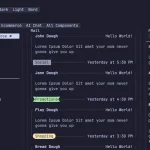| Author: | mesca |
|---|---|
| Views Total: | 771 views |
| Official Page: | Go to website |
| Last Update: | September 12, 2018 |
| License: | MIT |
Preview:

Description:
SensorChart is a simple, fast JavaScript library that renders an animated chart to visualize real-time streaming data (e.g. fps) using Canvas and WebGL (Web Graphics Library) API.
How to use it:
Include the necessary regl and regl-line2d to handle WebGL 2D graph.
<script src="/path/to/regl.js"></script> <script src="/path/to/line2d.js"></script>
Include the SensorChart library.
<script src="/path/to/sensorchart.js"></script>
Create a canvas element on which you want to render the chart. Do not set the height and width attributes, use CSS instead.
<canvas id="chart"></canvas>
The example JavaScript to create a chart.
// Play with this!
let channels = 7; // Number of lines
let rate = 20; // Number of samples per second
let scale = 5; // Milliseconds per pixel
let min = -1; // Minimum y value
let max = 1; // Maximum y value
let stack = true; // Stack timeseries on top of each other
// Rainbows!
let colors = ['#9400D3', '#FF0000', '#FF7F00', '#FFFF00', '#00FF00', '#0000FF', '#4B0082'];
// This will hold our time-series objects.
let series = [];
// Display the FPS.
function display(fps) {
document.getElementById('fps').textContent = Math.round(fps);
}
// Append new sample.
function append() {
let now = Date.now();
for (let i = 0; i < channels; i++) {
let value = Math.random() * (max - min) + min;
// The append method takes a timestamp and a value.
series[i].append(now, value);
}
}
// Create a new chart, passing the HTML canvas element and some options.
// See the API documentation for the full list of supported options.
let chart = new Chart(document.getElementById('chart'), {scale: scale, stack: stack});
for (i = 0; i < channels; i++) {
// Cosmetics.
color = colors[(i + 1) % colors.length];
// Create a new time-series object.
// See the API documentation for the full list of supported options.
series.push(new Series({min: min, max: max, color: color, thickness: 2}))
// Attach the new time-series to the chart.
// You can attach as many time-series as you want.
chart.addSeries(series[i]);
}
// Create a new scheduler.
// It takes an optional callback that will receive the FPS at each frame.
let scheduler = new Scheduler(display);
// Attach the chart to the scheduler.
// You can attach as many charts as you want.
scheduler.addChart(chart);
// Start the scheduler.
// You can stop it with scheduler.stop().
scheduler.start();
// Generate random data.
// In real life, you would probably receive data from a websocket.
setInterval(append, 1000 / rate);All default options.
- scale: milliseconds per pixel
- offset: the time offset, in milliseconds
- stack: stack multiple series
- background: the background color
- foreground: the grid color
- thickness: the grid thickness
- sections: the number of vertical sections in the grid
- tick: the tick marker, in milliseconds
{
min: -1,
max: 1,
scale: 20,
offset: -150,
background: '#E8E8E8',
foreground: '#808080',
thickness: 1,
sections: 2,
tick: 1000
};









